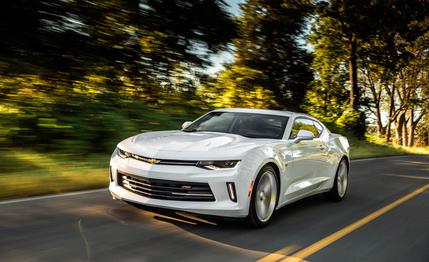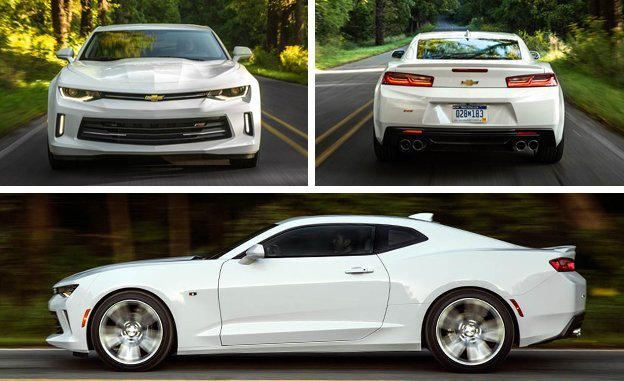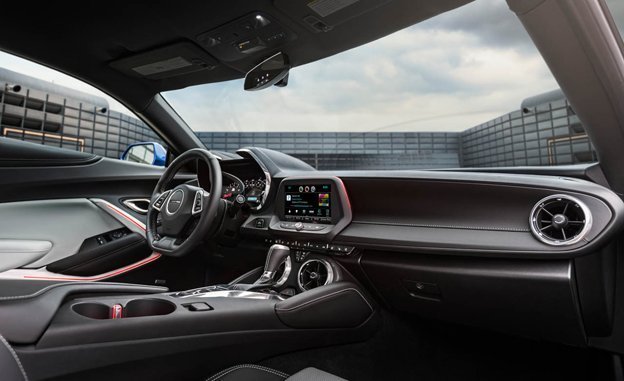 First Drive Review
First Drive Review
Today, the muscle car is in flux. While the V-8 pony cars still reign—and are ridiculously powerful—Detroit has attempted to shift the cars’ focus on straight-line prowess to more worldly pursuits, such as turning. (Yes, in both directions.) And they’ve even made the muscle machines with fewer than eight cylinders worth a damn, too. Take, for example, the V-6–powered, automatic-equipped 2016 Chevrolet Camaro pictured here. Not long ago, this combination of vehicle, engine, and transmission would have amounted to little more than the interesting alternative to the Chevy Lumina at the rental counter. No longer.
Like its fire-breathing V-8–powered SS sibling, the six-cylinder 2016 Camaro is lighter and slightly smaller than before and also more powerful. In fact, with 335 horsepower and 284 lb-ft of torque, the V-6 not only is 12 horsepower stronger than the 2015 Camaro’s six, it also has bragging rights over the 5.7-liter V-8 in the fourth-generation Camaro SS. Almost entirely redesigned, the V-6 still displaces 3.6 liters and features aluminum construction, yet it now has a one-millimeter-larger bore, and it can shut down a few cylinders to save fuel.

Where the V-6 fits into the 2016 Camaro’s engine lineup is nearly as important as its impressive specs. Unbound by Ford’s EcoBoost marketing pressures, which led the Blue Oval to make its turbo four the Mustang’s mid-grade engine, Chevy has made the V-6 engine the Camaro’s middle offering. This leaves the less powerful (but torquier) turbocharged four-cylinder as the new base motivator; we haven’t driven the Camaro with the 2.0-liter four—that will happen early next year—but doing so isn’t a prerequisite to declaring the V-6 model a success.
Adopting General Motors’ Alpha rear-drive platform and tidying up the dimensions has shaved some 300 pounds (as shown by our test of the manual V-6) versus the outgoing car. With less weight to lug around, the V-6 pulls surprisingly hard and sounds fantastic while doing so. The car we drove was equipped with the optional dual-mode exhaust, which modulated the six’s volume between a raspy burble just off idle to a zingy scream at higher engine speeds, and added sharp crescendos to full-throttle upshifts. For those accustomed to writing off V-6 muscle cars because they lack a V-8’s aural signature, give this Camaro a listen; it might not have a V-8’s barrel-chested voice, but it speaks in the same accent.
The optional eight-speed automatic is nearly as flawless, its only demerit being that it isn’t the standard six-speed manual. This isn’t the ultraquick-shifting 8L90 unit deployed in the Corvette and the Camaro SS, but rather the Hydra-Matic 8L45—again, lifted from Cadillac—but its gearchanges are nonetheless well timed and firm. The programming is excellent, and the shift protocol changes depending on which drive mode is selected. Chevy limits the V-6 models to Tour, Snow/Ice, and Sport modes—the SS adds a “Track” setting—and they also alter the Camaro’s steering effort, throttle calibration, and the optional dual-mode exhaust. Only the cheesy small plastic shift paddles take some air out of the automatic’s balloon.

Sitting behind the wheel of the V-6 Camaro feels a lot like sitting in the SS: You won’t be able to see much of anything to the sides or rear, the forward view is severely pinched by the gauge-cluster hood, and the standard 7.0-inch touch screen is curiously tilted downward and therefore can be difficult to read. The base seats, however, are quite comfortable and well bolstered, and the small-diameter flat-bottom steering wheel is a delight to wield.
If Chevrolet needed to get two things right about the Camaro’s insides, the seats and wheel are it, because the V-6 Camaro is more sports car than rental car. Using Chevy’s figures, the automatic-equipped V-6 coupe is 250 pounds lighter than the stick-shift V-8 Camaro, and it feels that way. The nose changes direction with more eagerness, the standard suspension keeps body motions in check (adaptive dampers are available only on the SS), and the steering response is sharp and immediate. The SS turns in more violently, but that comes courtesy of wider summer tires that aren’t available on the V-6. All-season rubber aside, while Ford leaves the V-6 Mustang to wallow in a relatively option-free zone below the EcoBoost, Chevy allows V-6 buyers to add a performance-enhancing package with Brembo brakes, an external engine-oil cooler, and an auxiliary radiator.
Driving the V-6 is an altogether separate experience from piloting the SS, which feels a bit like a taller Corvette Stingray with a vestigial back seat, but both are fantastic. Yet there’s no reason to feel swindled if you get the V-6; it returns the right sensations, makes the right noises, and delivers dynamic fidelity on par with far less humble cars. It’s a holistic and well-rounded thing, and it should have every Camaro intender double-checking their eight-cylinder desires.